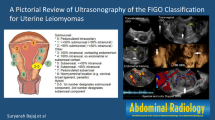Abstract
Purpose
To compare the clinical results of three techniques of hysterectomy- abdominal hysterectomy (AH), non-descent vaginal hysterectomy (NDVH), and laparoscopic-assisted vaginal hysterectomy (LAVH).
Methods
A simple prospective randomized study was performed in a tertiary care centre between June 2011 and Dec 2012, among 150 consecutive women indicated to undergo hysterectomy for benign and mobile uterine conditions. They were randomly assigned 50 each to three routes of hysterectomy; (abdominal, vaginal, and laparoscopic-assisted vaginal). Outcome measures including operating time, blood loss, rate of complications, consumption of analgesics, and length of hospital stay were assessed and compared between groups.
Results
As far as duration of operation, mean blood loss, analgesic requirement, length of hospital stay, P value was significant. Incidence of complications is least among VH group.
Conclusion
Vaginal hysterectomy is the gold standard in the era of minimal access surgery. Some of the contraindications to VH can be overcome by assistance of laparoscope and a potential abdominal hysterectomy can be converted to a vaginal procedure.
Similar content being viewed by others
References
Clinch J. Length of hospital stay after vaginal hysterectomy. Br J Obstet Gynaecol. 1994;101(3):253–4.
Reich H., De Caprio J., McGlynn F., 1989. Laparoscopic Hysterectomy. J. Gynecolo Surg, 5:213-216 Volume 335:512-513 August 15, 1996 Number 7.
Dicker RC, Greenspan JR, Strauss LT et al. Complications of abdominal and vaginal hysterectomy among women of reproductive age in the United States. Am J Obstet Gynecol. 1982;144:841–8.
Garry R, Fountain J, Mason S et al. The eVALuate study: two parallel randomised trials, one comparing laparoscopic with abdominal hysterectomy, the other comparing laparoscopic with vaginal hysterectomy. BMJ. 2004;328(7432):129–33. Epub 2004 Jan 7.[PMC free article] [PubMed].
Kovac SR. Decision-directed hysterectomy: a possible approach to improve medical and economic outcomes. Int J Gynaecol Obstet. 2000;71:159–69.
Kovac SR, Barhan S, Lister M et al. Guidelines for the selection of the route of hysterectomy: application in a resident clinic population. Am J Obstet Gynecol. 2002;187:1521–7.
ACOG Committee Openion. Number 311, April 2005. Appropriate use of laparoscopically assisted vaginal hysterectomy. Obstet Gynecol. 2005;105: 929-30.
Meikle SF, Nugent EW, Orleans M. Complication and recovery for laparoscopic-assisted vaginal hysterectomy compared with abdominal and vaginal hysterectomy. Obstet Gynecol. 1997;89:304–11.
Lumsden MA, Twaddle S, Hawthorn R et al. A randomised comparison and economic evaluation of laparoscopic-assisted hysterectomy and abdominal hysterectomy. Br J Obstet Gynaecol. 2000;107(11):1386–91.
Price JH, Nassief SA. Laparoscopic-assisted vaginal hysterectomy: initial experience. Ulster Med J.1996;65(2):149–51. [PMC free article] [PubMed].
Campbell ES, Xiao H, Smith MK. Types of hysterectomy: comparison of characteristics, hospital costs, utilization and outcomes. J Reprod Med. 2003;48(12):943–9.
Garry R. The best way to determine the best way to undertake a hysterectomy (commentary). BJOG. 2009;116:473–7.
Acknowledgments
We acknowledge all participants who consented to be a part of our study, the statistical analyst for his help, and the EDP dept of the institution for their kind cooperation in the making of this article and its submission.
Compliance with ethical requirements and Conflict of interest
All procedures followed were in accordance with the ethical standards of the responsible committee on human experimentation (institutional and national) and with the Helsinki Declaration of 1975, as revised in 2008 (5). Informed consent was obtained from all patients for being included in the study. Sandhaysri Panda, Askok K. Behera, M. Jayalaxmi, T. Narasinga Rao & G. Indira declare that they have no conflicts of interest.
Author information
Authors and Affiliations
Corresponding author
Rights and permissions
About this article
Cite this article
Panda, S., Behera, A.K., Jayalakshmi, M. et al. Choosing the Route of Hysterectomy. J Obstet Gynecol India 65, 251–254 (2015). https://doi.org/10.1007/s13224-014-0562-z
Received:
Accepted:
Published:
Issue Date:
DOI: https://doi.org/10.1007/s13224-014-0562-z




